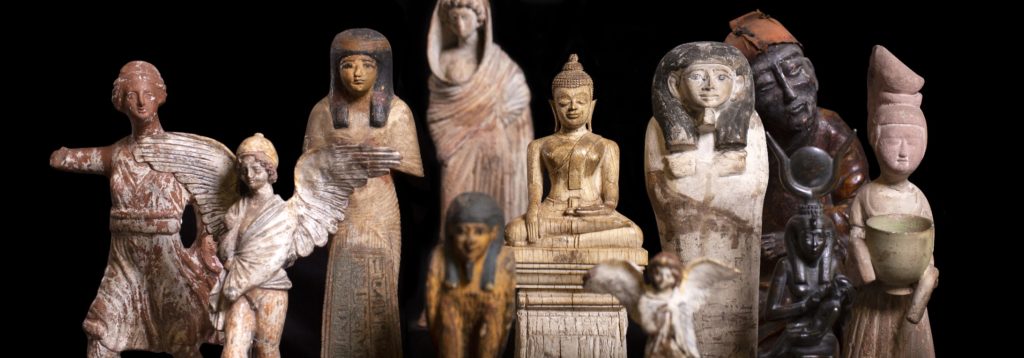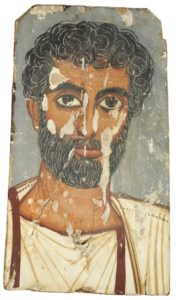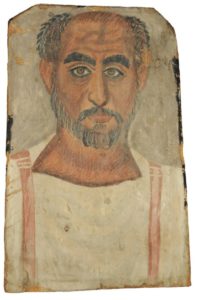
Fayum mummy portraits are highly naturalistic paintings on wooden boards. They were attached to the mummified bodies of wealthy Egyptians in Roman Period Egypt.
Freud’s collection of Egyptian antiquities is varied. Some objects are day-to-day items that would be found in an average Egyptian home. Many are funerary objects, designed to be buried with the body of the deceased and accompany them in the afterlife. Shabti figures are such items, carved to resemble servants, animals and even tools in order to undertake mundane tasks and chores on behalf of the dead person in the afterlife.
Fayum mummy portraits are a little different. Produced only for the most wealthy members of society, the naturalistic portraits sought to preserve their image after death. In modern times they are rare and were highly sought-after by experienced collectors and museums. Freud owned two, which remain in his collection to this day.
Unknown Artist
Fayum mummy portrait of middle-aged man, c.250 AD – 300 AD
Freud Museum London reference: 4946
This portrait acted as a ‘death mask’ to be bound to its subject after he was mummified. Wealthy Egyptians wanted their portraits to appear as realistic as possible to preserve their image after death.
The man in this portrait is unknown. He is an unusual subject, as most mummy portraits show their subjects at a young age or even as children. He could have been a powerful member of the military, civil service or clergy from the city of Fayum, but his true identity remains a mystery.
The vivid colours are made from hot beeswax mixed with coloured pigments painted onto a wooden board. The flesh is warm in tone, with thick diagonal brushwork suggesting shading. The lines on the brow are loose but detailed, drawn in grey, as are the folds on the tunic. The style is similar to Roman art of the period and Egypt was at this time under Roman rule. The date in the early decades of the third century is also suggested by the hairstyle and the relative simplicity of the brushwork.
Sigmund Freud was a great collector of Egyptian art and bought this painting from the Austrian art dealer Theodor Graf.
Fayum portraits belong to the tradition of panel painting and are one of the most highly regarded forms of art in the Classical world.
Unknown Artist
Fayum mummy portrait of man with beard, c.250 AD – 300 AD
Freud Museum London reference: 4947
After mummification, wealthy Egyptians were embalmed and buried with many possessions to use in the afterlife.
The purpose of the masks was to preserve the deceased’s image after death. Often the portraits would be painted during a person’s lifetime and displayed in the home for use after death. Though this sounds morbid to us, it often meant that subjects were immortalised at their most youthful and attractive. Like the portrait above, the vivid colours here are again made from hot beeswax mixed with coloured pigments painted onto a wooden board. This portrait clearly has more ‘losses’ to the paintwork and is not as well preserved as Freud’s other portrait.
The man’s identity will remain a mystery to us, though his hairstyle indicates an early Antonine date. Sigmund Freud bought this painting from the same Austrian art dealer, Theodor Graf. In the late 19th century Egyptian artefacts became fashionable collectables in Europe, making Victorian explorers and ‘tomb raiders’ race to uncover new artworks and treasures.
Freud and Egypt
Though both artefacts are usually safely stored away for conservation reasons, you can see the portrait 4946 for a limited time only in the exhibition Between Oedipus and the Sphinx: Freud and Egypt. The exhibition runs until 27 October 2019.




